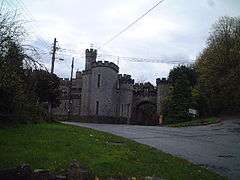Banwell Castle
| Banwell Castle | |
|---|---|
.jpg) | |
| Location | Banwell, Somerset, England |
| Coordinates | 51°19′25″N 2°51′36″W / 51.32361°N 2.86000°WCoordinates: 51°19′25″N 2°51′36″W / 51.32361°N 2.86000°W |
| Built | 1847 |
| Built for | John Dyer Sympson |
| Architect | Augustus Pugin |
| Architectural style(s) | Victorian Gothic Revival |
Listed Building – Grade II* | |
| Official name: Banwell Castle, terraces and courtyard walls | |
| Designated | 9 February 1961[1] |
| Reference no. | 350213 |
Listed Building – Grade II* | |
| Official name: Coachhouse at Banwell Castle | |
| Designated | 17 January 1984[2] |
| Reference no. | 33347 |
Listed Building – Grade II* | |
| Official name: Gatehouse, stables and flanking walls at Banwell Castle | |
| Designated | 9 February 1961[3] |
| Reference no. | 33348 |
Listed Building – Grade II* | |
| Official name: Terrace and dairy at Banwell Castle | |
| Designated | 17 January 1984[4] |
| Reference no. | 33349 |
Listed Building – Grade II* | |
| Official name: West garden walls with towers at Banwell Castle | |
| Designated | 17 January 1984[5] |
| Reference no. | 33350 |
 Location of Banwell Castle in Somerset | |
Banwell Castle is a Victorian Gothic Revival mansion in Banwell, Somerset, England. It is a Grade II* listed building.[1] The castle buildings, now a hotel and restaurant, and sometimes used as a wedding venue,[6] are set in 25 acres (10 ha) of grounds which are used for hawking activities.[7]
History
The land on which the house is built was owned by the Bishop of Bath and Wells. It was sold to John and Joan Landown in 1753. It was passed down to the Sympson family; John Dyer Sympson, a solicitor from London built the castle as his home. It was completed in 1847 to a design by Augustus Pugin.[8] Having passed to Sir William Baker,[8] it was expanded and embellished in the 1880s by Sir Elskin Baker.[9]
The castle was bought and sold many times in the subsequent 100 years. In World War II it was taken over by the Royal Air Force and used as the headquarters for No. 955 Squadron, which was a barrage balloon unit and part of Balloon Command. The gatehouse was used by the local Air Raid Precautions.[8]
In 1956 the estate was sold to Simon and Phillipa Wills (of W.D. & H.O. Wills). Until 1988 the owners were Charles Skilton, a book and postcard publisher, and Jean Desebrock from South Africa. They sold it to William and Hugh Parsons who converted it into a hotel and restaurant.[8]
Architecture

The house has five windows in the three-storey main block between small circular turrets with other octagonal and hexagonal towers. In front of the house is a terrace with a trefoil pierced parapet with statutes of lions rampant with swords on embattled octagonal gate piers which flank six steps.[1]
The coachhouse has a tall circular turret and contained a granary on the first floor.[2] The gatehouse consists of a Chamfered double arch, with a parapet between circular embattled towers, with cast iron gates with heraldic motifs.[3] The walled kitchen garden, 170 metres (560 ft) south east of the house has another 4 metres (13 ft) tower.[10] The terrace adjoining the house leads to a decorative dairy.[4] The west garden walls include another tower.[5]
References
- 1 2 3 "Banwell Castle detailed record". Images of England. Archived from the original on 8 December 2007. Retrieved 24 October 2007.
- 1 2 "Coachhouse at Banwell Castle". Images of England. English Heritage. Archived from the original on 6 June 2011. Retrieved 6 April 2010.
- 1 2 "Gatehouse, stables and flanking walls at Banwell Castle". Images of England. English Heritage. Archived from the original on 6 June 2011. Retrieved 6 April 2010.
- 1 2 "Terrace and dairy at Banwell Castle". Images of England. English Heritage. Archived from the original on 6 June 2011. Retrieved 6 April 2010.
- 1 2 "West garden walls with towers at Banwell Castle". Images of England. English Heritage. Archived from the original on 6 June 2011. Retrieved 6 April 2010.
- ↑ "Banwell Castle". North Somerset Council. Archived from the original on 13 October 2010. Retrieved 6 April 2010.
- ↑ "Banwell Hawk Walks". Banwell Hawk Walks. Retrieved 6 April 2010.
- 1 2 3 4 "History". Banwell Castle. Retrieved 6 April 2010.
- ↑ Holt, Jonathan (2007). Somerset Follies. Bath: Akeman Press. p. 6. ISBN 978-0-9546138-7-7.
- ↑ "Kitchen garden wall and tower 170 metres south east of Banwell Castle". Images of England. English Heritage. Archived from the original on 6 June 2011. Retrieved 6 April 2010.